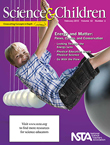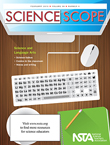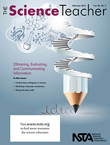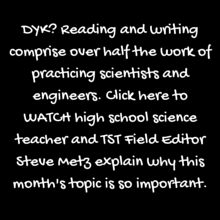NSTA’s K–12 Science Education Journals: February 2015 Issues Online
By Lauren Jonas, NSTA Assistant Executive Director
Posted on 2015-02-04
Energy and Matter; Science and Language Arts; and Obtaining, Evaluating, and Communicating Information—these are the themes of the February 2015 journal articles from the National Science Teachers Association (NSTA). Browse through the thought-provoking selections below and learn more about how your brain pays attention, the synergy between physical education and physical science, reading and writing alignment across content areas, teaching graph literacy, confronting ambiguity in science, modeling molecular machinery, the Next Generation Science Standards (NGSS), and other important topics in K–12 science education.
Science and Children
 Energy and Matter is one of the most difficult of the crosscutting concepts in the Next Generation Science Standards for elementary teachers to develop. The ideas, tips and strategies in this issue of S&C will help equip you to introduce this crosscutting concept to your students
Energy and Matter is one of the most difficult of the crosscutting concepts in the Next Generation Science Standards for elementary teachers to develop. The ideas, tips and strategies in this issue of S&C will help equip you to introduce this crosscutting concept to your students
Featured articles (please note, only those marked “free” are available to nonmembers without a fee):
- Free – Editor’s Note: Energy and Matter
- Go With the Flow
- How Does My Brain Pay Attention?
- Inquiry-Based Science and the Next Generation Science Standards: A Magnetic Attraction
- Free – Looking Through the Energy Lens
- Physical Education Meets Physical Science
- Full Table of Contents
Science Scope
 The Common Core State Standards for English language arts (CCSS ELA) and the Next Generation Science Standards (NGSS) share common goals for student literacy. This issue explores strategies for achieving literacy in science and technical subjects for students in grades 6–8.
The Common Core State Standards for English language arts (CCSS ELA) and the Next Generation Science Standards (NGSS) share common goals for student literacy. This issue explores strategies for achieving literacy in science and technical subjects for students in grades 6–8.
Featured articles (please note, only those marked “free” are available to nonmembers without a fee):
- Comic Relief: Using Comics and Illustrated Trade Books to Support Science Learning in First-Year English Language Learners
- Free – Editor’s Roundtable: Literacy Provides Common Ground for standards
- Free – Reading and Writing Alignment Across Content Areas
- Science Haiku Art
- Teaching Graph Literacy Across the Curriculum
- The Who, What, When, Where, and How of Waves
- Using Disciplinary Literacy Strategies to Enhance Student Learning
- Full Table of Contents
The Science Teacher
 It’s arguable that all science learning begins and ends with obtaining, evaluating, and communicating information. We think of scientists and engineers working in the laboratory or outside during field research, but it turns out that reading and writing comprise over half the work of practicing scientists and engineers. Communicating science and engineering understanding is challenging, but the rewards are great, giving students a unique opportunity to synthesize ideas and solidify understanding. You can start by having students keep a science notebook or journal—including drawings, numbers, and words. We hope this issue inspires you to reinforce this important practice in the classroom. YouTube fans, watch high school science teacher and TST Field Editor, Steve Metz, introduce this month’s issue. Metz explains why this month’s topic so important. For starters, did you know that reading and writing comprise over half the work of practicing scientists and engineers?
It’s arguable that all science learning begins and ends with obtaining, evaluating, and communicating information. We think of scientists and engineers working in the laboratory or outside during field research, but it turns out that reading and writing comprise over half the work of practicing scientists and engineers. Communicating science and engineering understanding is challenging, but the rewards are great, giving students a unique opportunity to synthesize ideas and solidify understanding. You can start by having students keep a science notebook or journal—including drawings, numbers, and words. We hope this issue inspires you to reinforce this important practice in the classroom. YouTube fans, watch high school science teacher and TST Field Editor, Steve Metz, introduce this month’s issue. Metz explains why this month’s topic so important. For starters, did you know that reading and writing comprise over half the work of practicing scientists and engineers?
 Featured articles (please note, only those marked “free” are available to nonmembers without a fee):
Featured articles (please note, only those marked “free” are available to nonmembers without a fee):
- Beyond an Equation
- Confronting Ambiguity in Science
- Doing the Data Walk
- Free – Editor’s Corner: Obtain, Evaluate, Communicate!
- Modeling Molecular Machinery
- Sinking In
- Full Table of Contents
Get these journals in your mailbox as well as your inbox—become an NSTA member!
Follow NSTA
Disclaimer: The views expressed in this blog post are those of the author(s) and do not necessarily reflect the official position of the National Science Teaching Association (NSTA).


